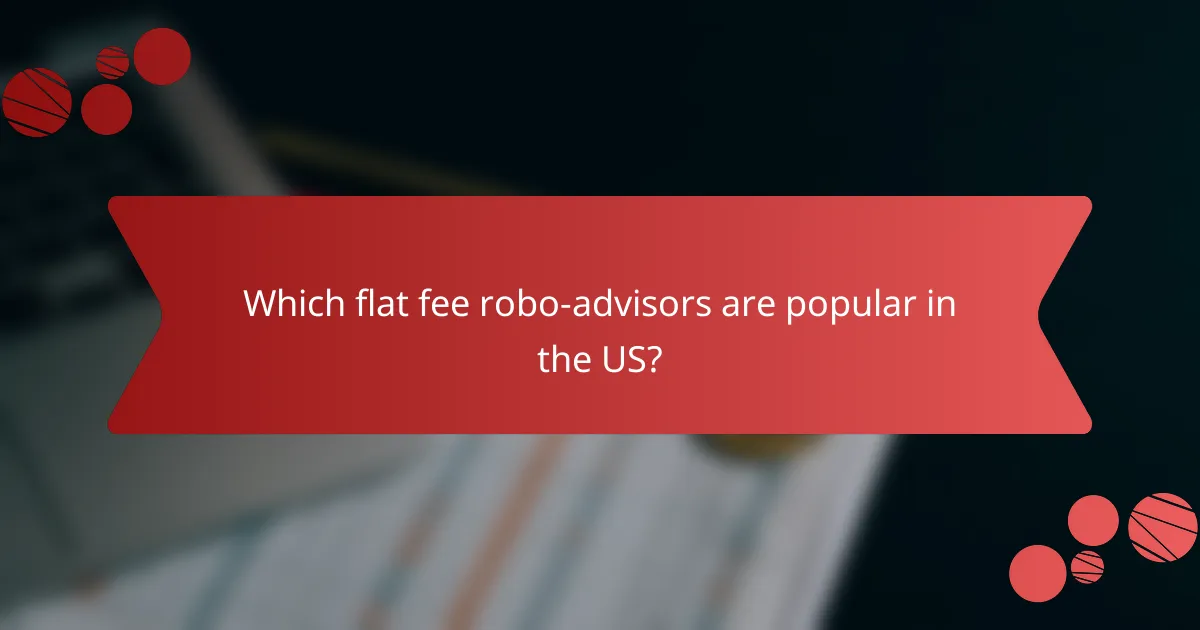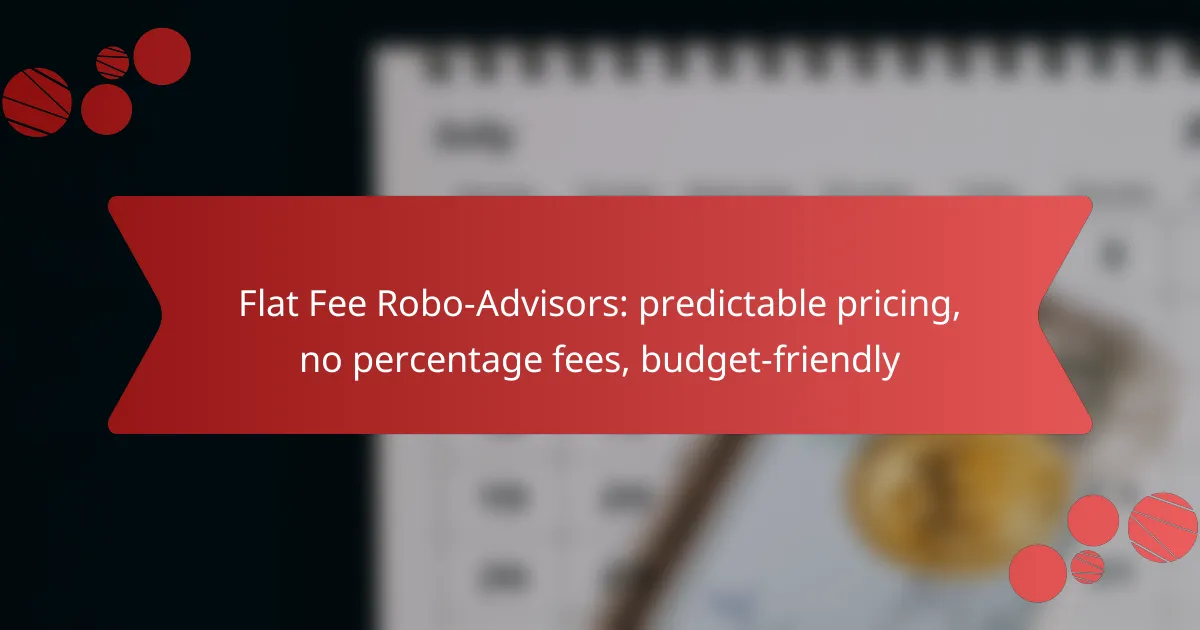Flat fee robo-advisors provide a transparent pricing structure by charging a fixed fee for their investment management services, rather than a percentage of assets under management. This model not only offers predictable costs but also appeals to budget-conscious investors, allowing for better financial planning and potentially higher returns on larger portfolios.

What are flat fee robo-advisors?
Flat fee robo-advisors are investment platforms that charge a fixed fee for their services instead of a percentage of assets under management. This pricing model provides predictable costs, making them budget-friendly options for investors seeking automated financial advice.
Definition of flat fee robo-advisors
Flat fee robo-advisors offer automated investment management for a set fee, typically charged annually or monthly. This fee structure allows clients to know exactly what they will pay, regardless of their investment balance. These platforms often provide portfolio management, rebalancing, and financial planning services.
Investors can benefit from this model as it eliminates the uncertainty of fluctuating fees based on portfolio performance. This can be particularly advantageous for those with larger investment amounts, as percentage-based fees can accumulate significantly over time.
Comparison with traditional robo-advisors
Traditional robo-advisors usually charge a percentage of assets under management, typically ranging from 0.25% to 1%. In contrast, flat fee robo-advisors provide a more stable cost structure, which can be more appealing for investors who prefer predictable expenses.
For example, if an investor has a portfolio worth $100,000, a traditional robo-advisor charging 0.5% would cost $500 annually, while a flat fee advisor might charge a fixed rate of around $300. This difference can lead to significant savings over time, especially for larger portfolios.
However, flat fee robo-advisors may not be suitable for everyone. Investors with smaller portfolios might find that percentage-based fees are more economical, as the fixed fee could represent a higher percentage of their total investment. It’s essential to evaluate personal financial situations and investment goals when choosing between these options.

How do flat fee robo-advisors work?
Flat fee robo-advisors operate by charging a fixed annual fee for their investment management services, rather than a percentage of assets under management. This pricing model allows clients to predict their costs and can be more budget-friendly for those with larger portfolios.
Investment process overview
The investment process with flat fee robo-advisors typically begins with an online questionnaire that assesses your financial goals, risk tolerance, and investment preferences. Based on your responses, the robo-advisor creates a tailored investment portfolio, often consisting of low-cost exchange-traded funds (ETFs).
Fee structure explanation
Flat fee robo-advisors charge a fixed fee that can range from a few hundred to a couple of thousand dollars annually, depending on the provider and the services included. This fee structure is advantageous for investors with larger portfolios, as it can lead to significant savings compared to percentage-based fees, which typically range from 0.25% to 1% of assets under management.
It’s essential to understand what services are included in the flat fee. Some platforms may offer comprehensive financial planning or tax optimization, while others may focus solely on investment management. Always review the details to ensure you’re getting the value you expect for the fee you pay.

What are the benefits of flat fee robo-advisors?
Flat fee robo-advisors offer a clear pricing structure that eliminates percentage-based fees, making them an attractive option for budget-conscious investors. This model allows clients to know exactly what they will pay, enabling better financial planning and potentially higher returns on investment.
Predictable pricing advantages
One of the main benefits of flat fee robo-advisors is predictable pricing. Clients pay a fixed fee, which can be monthly or annually, regardless of their investment amount. This transparency helps investors avoid unexpected costs that can arise with percentage-based fees, especially as their portfolios grow.
For example, if a robo-advisor charges a flat fee of $300 per year, an investor with a $50,000 portfolio pays the same as someone with a $500,000 portfolio. This can be particularly advantageous for those with larger investments, as they can save significantly compared to traditional percentage-based models.
Cost savings compared to percentage fees
Flat fee robo-advisors can lead to substantial cost savings over time compared to percentage-based fees. Traditional robo-advisors often charge around 0.25% to 1% of assets under management annually. For a $100,000 portfolio, this could mean paying between $250 and $1,000 each year, depending on the fee structure.
In contrast, a flat fee of $300 per year would represent a much lower cost for the same portfolio size, allowing investors to retain more of their returns. Over the long term, these savings can compound, making a significant difference in overall investment growth.

Which flat fee robo-advisors are popular in the US?
Popular flat fee robo-advisors in the US offer predictable pricing structures without percentage-based fees, making them budget-friendly options for investors. These platforms typically charge a fixed annual fee, allowing users to manage their investments without worrying about fluctuating costs based on account size.
Wealthfront
Wealthfront is a well-known flat fee robo-advisor that charges a fixed annual fee for its services, which includes automated investment management and financial planning tools. With a fee of around $500 annually for accounts up to $500,000, it provides a cost-effective solution for those looking to grow their wealth without high management costs.
Investors can benefit from Wealthfront’s tax-loss harvesting feature and personalized financial advice, making it a comprehensive choice for many. Additionally, its user-friendly interface and mobile app enhance the overall experience, allowing clients to easily track their investments.
Betterment
Betterment is another popular flat fee robo-advisor that offers a straightforward pricing model, charging a fixed annual fee based on the account balance. For accounts under $100,000, the fee is typically around $300 per year, making it accessible for new investors.
Betterment’s services include automatic rebalancing, tax-loss harvesting, and personalized financial advice. This platform is particularly appealing for those who prefer a hands-off investment approach, as it handles all aspects of portfolio management while keeping costs predictable.

How to choose a flat fee robo-advisor?
Choosing a flat fee robo-advisor involves evaluating pricing structures, services offered, and overall value. Look for platforms that align with your investment goals and budget while providing transparent fees without percentage-based charges.
Criteria for selection
When selecting a flat fee robo-advisor, consider factors such as the advisor’s reputation, regulatory compliance, and user reviews. Ensure the platform is registered with relevant authorities, such as the SEC in the United States, to guarantee a level of security and trust.
Evaluate the minimum investment requirements, as some robo-advisors may have thresholds that could affect your ability to start investing. Additionally, assess the range of services provided, including tax-loss harvesting, financial planning, and portfolio rebalancing.
Key features to consider
Look for user-friendly interfaces and mobile access, which can enhance your investment experience. A good robo-advisor should offer clear reporting tools and educational resources to help you understand your investments better.
Consider whether the robo-advisor provides personalized investment strategies based on your risk tolerance and financial goals. Some platforms may offer additional features like socially responsible investing options or access to human advisors for more complex needs.
Lastly, check for any hidden fees or additional costs that may arise, such as trading fees or account maintenance charges, to ensure you are fully aware of the total cost of using the service.

What are the risks of flat fee robo-advisors?
Flat fee robo-advisors can offer predictable pricing, but they also come with specific risks that investors should consider. These include potential downsides related to service limitations and the impact of market volatility on investment performance.
Potential downsides
One significant downside of flat fee robo-advisors is that they may provide limited personalized advice compared to traditional financial advisors. While they often automate investment management, they might not address unique financial situations or complex needs effectively.
Additionally, the flat fee structure may not be cost-effective for smaller investment portfolios. For instance, if your investment is modest, the flat fee could represent a higher percentage of your overall investment compared to a percentage-based fee structure.
Market volatility impact
Market volatility can significantly affect the performance of investments managed by flat fee robo-advisors. Unlike percentage-based models, where fees decrease during downturns, flat fees remain constant regardless of market conditions, potentially leading to higher relative costs during tough times.
Investors should be aware that during periods of high volatility, the flat fee may not provide the same value as a percentage-based fee, especially if the portfolio experiences substantial losses. It’s crucial to assess whether the flat fee aligns with your investment strategy and risk tolerance, particularly in uncertain market conditions.

How do flat fee robo-advisors compare to human advisors?
Flat fee robo-advisors typically offer a more predictable pricing structure compared to human advisors, who often charge a percentage of assets under management. This can make robo-advisors a budget-friendly option for individuals looking to manage their investments without incurring high fees.
Cost comparison
Flat fee robo-advisors generally charge a fixed annual fee, which can range from a few hundred to a couple of thousand dollars, depending on the services provided. In contrast, human advisors often charge around 1% of assets under management, which can add up significantly over time, especially for larger portfolios.
For example, on a $100,000 investment, a flat fee of $500 would be much cheaper than a 1% fee, which would cost $1,000 annually. This cost difference can be a crucial factor for budget-conscious investors.
Service level differences
While flat fee robo-advisors provide automated investment management and portfolio rebalancing, they may lack the personalized service that human advisors offer. Human advisors can provide tailored financial planning, emotional support during market fluctuations, and customized investment strategies based on individual goals.
However, many flat fee robo-advisors are enhancing their services by offering access to financial planning tools and educational resources. Investors should consider their need for personalized advice versus the cost savings of a flat fee service when choosing between the two options.

